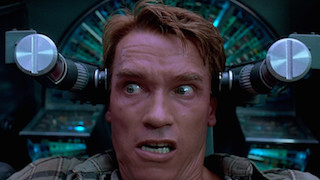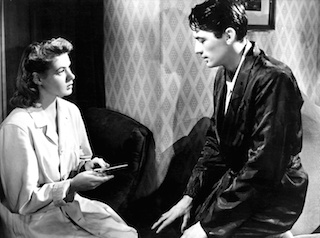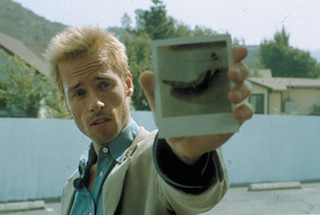The great thing about memory loss movies is…something important. Huh, well, I seemed to have forgotten.
Anyway, with the impending release of Pixar’s latest, the most memorable and impactful character from Finding Nemo, Dory the blue tang fish, returns. Voiced, once again, by comedian and talk show host Ellen Degeneres, we last let her living a new life among friend Marlon and Nemo and making a home for herself in their coral reef. However, her memory problems remain and it leads her on a new adventure to find her family.
As Dory’s short-term memory loss condition proved in the first movie, memory can often be unreliable and clouded with elapsed time. Throw a traumatic experience into the mix and the brain’s reaction to said trauma is, despite major advances in the medical field, often a mystery. It is no surprise Hollywood has often made the enigmatic conditions of the brain and memory into compelling and profound narratives.
Today’s Top 5 is delving into the recesses of the mind to recall five movies from cinema’s past that use memory loss as a major plot device or theme. Jog your memories with us as we travel as far as Mars and as close as the inner workings of your mind. Spooky, right?
[divider top=”no”]
5) Total Recall
I’m not even going to talk about the messy, no good 2013 remake of this movie. I’m only referring to Paul Verhoeven’s classic 1990 based on the short story by renowned Sci-Fi writer Philip K. Dick. Verhoeven utilizes at-the-time-rising action star Arnold Schwarzenegger as Douglas Quaid, who goes from a construction worker with a beautiful wife (Sharon Stone) and strange dreams about Mars, to a secret agent in hiding through a memory wipe. He must travel to Mars to uncover the work of his former boss, Cohaagen.
Much like Verhoeven’s 1987 classic Robocop, Verhoeven tackles a dystopian future that presents a future filled with satiric barbs as everything from technological advancement, human ingenuity, advertising, and consumerism. These elements are at work mostly in the background, in TV commercials that play while characters walk through the futuristic world or when dialogue is taking place. Also, his imagination is unlike any other and allows for things like exploding heads, eye-bulging robots, and Kuato. You can never get Kuato out of your head after that scene.
These dressings adorn Verhoven’s more biting commentary on social issues like racism, classism, social hierarchy, exploitation of the poor and working class, and even environmental issues. All of it is played for laughs, but Verhoeven’s satire is often forward-thinking enough to land a hard blow in 2016. A lot of Verhoeven’s filmography has proven to have the same prescient voice as Philip Dick’s Sci-Fi writings. We can only hope companies have the compassion and foresight to avoid our future allowing for minds to be wiped and Kuatos to grow out of our torsos. See you at the party, Richter.
[divider top=”no”]
4) Spellbound
Ingrid Bergman plays Dr. Constance Petersen, a young psychoanalyst at Green Manors asylum. When the head of the asylum, Dr. Merchuson, plans to retire, he is replaced by a famous psychiatrist, Dr. Anthony Edwardes, played by Gregory Peck. However, all is not as it seems with the new head of the asylum. In a matter of a few days, it becomes apparent he is an impostor. However, before he can be apprehended, Dr. Petersen vows to help the man, as he is an amnesiac hiding a secret to the whereabouts of the real Dr. Edwards. She is taken by him and the two flee authorities as they seek to recover his memory and find out Dr. Edwardes fate.
Although the movie is surrounded by tremendous controversy, given Hitchcock’s visionary nature clashing with studio Hollywood, the final product was one of the best films of 1945. Ever the master of the film-noir, Hitchcock employs everything from wonderful sound design, innovative camera work, and an Oscar-winning score by Miklos Rozsa–even though he hated the score–to heighten and maintain a gripping story and pulsing suspense. It balances romance between Peck and Bergman, stellar dialogue from screenwriter Ben Hecht–who also wrote Notorious for Hitchcock–and the science of the mind. This formula would be perfected by Hitchcock thirteen years later in a slightly different narrative, but with all the same parts, in his classic Vertigo. Spellbound is one of Hitchcock’s better non-horror psychological thrillers.
[divider top=”no”]
3) Memento
While the previous two entries followed a standard narrative, the final three movies on this list took the concept of memory loss and applied them to the narrative itself. In Christopher Nolan’s breakout hit, Guy Pearce plays Leonard, who suffers from anterograde amnesia, a condition where the sufferer loses the ability to create new memories after the event that caused the amnesia. Nolan plays with narrative structure, using the amnesia as a storytelling device to intersperse black-and-white scenes in chronological order with color scenes playing in reverse order. Nolan and his brother Jonathan, who wrote the short story on which Nolan would base the narrative, would win countless festival awards and were nominated for two Oscars.
While the major draw and thrill of the movie are the puzzle-like nature of the narrative, Pearce gives an astounding performance in the movie’s more subtle and human moments. Dealing with grief, loss, and self-deception, Leonard is caught in a prison of painful memories and a struggle to remember. Most of all, the genius of the movie lies in its portrayal of self-deception. Even the movie itself leaves us questioning if we can trust Leonard’s memories and should we really not believe Teddy’s “lies”. It’s not often a movie gives us reason to doubt the main protagonist, but the nature of Nolan’s film is so intricate, we are left to forever ponder the meaning and if that meaning, if deciphered, is true or even matters.
[divider top=”no”]
2) Mulholland Dr.
If Nolan’s Memento played with narrative structure in a brilliant, non-linear fashion, David Lynch would see Nolan’s non-linear narrative and raise movie-going audiences one heaping pile of confusion, surreal imagery, and dark comedy. Sounds like everything we’ve come to expect from Lynch, but in 2001’s Mulholland Dr., Lynch fashioned his magnum opus. Following the events of Rita (Laura Harring), an amnesiac, and Betty (Naomi Watts), an aspiring actress, they search for clues and an answer to who Rita is and why she was almost killed. Certain clues dot the movie but are interspersed among seemingly unrelated scenes involving Justin Theroux’s director character, Adam Kesher, a club named Silencio, and a mysterious man known only as The Cowboy.
Many attempts have been made to make a cohesive narrative, with Lynch providing ten clues in the liner of the 2002 DVD release, but no real satisfying narrative structure has ever been reached. Like any great piece of art, however, the view is in the eye of the beholder. It is simultaneously seen as a celebration of filmmaking and Hollywood but also a repudiation of Hollywood’s less glamorous and vile elements. So much so, the movie has affectionately been called a “poisonous valentine to Hollywood.” If you have not had a chance to see this movie, be prepared to not understand and be blown away at the same time. It’s powerful, moving, puzzling, and terrifying, yet worth your time.
[divider top=”no”]
1) Eternal Sunshine of the Spotless Mind
I caught up with this movie recently and as I began to put together this list it shot right to the top. How had I never seen this movie before? Starring Jim Carrey and Kate Winslet as a couple drifting apart, Carrey’s character, Joel, discovers Kate’s Clementine has seen a company that can erase him from her memory. After discovering this, he likewise goes through the same process, only to fall in love with her all over again as he revisits their time together while the memories are being erased. A moving story of love, loss, and the enduring faithfulness of real love, it also has a non-linear narrative you only begin to realize as the movie progresses.
Written by Charlie Kaufman, the story is the counter to Hollywood’s typical standard of an on-screen relationship and dares us to imagine what love between two imperfect humans, aka all of us, looks like. I can’t put it any better than fellow Reel World contributor Mark Wingerter put it in his review of the movie:
“So what are we as fallible beings, incapable of this kind of perfect love, to do? Clementine says something to Joel that stuck with me on my most recent viewing of the film. She says, “People have to share things, Joel. That’s what intimacy is.” That’s probably the best we can do, open ourselves to being vulnerable and known truly by those we love. It will always more painful than strapping ourselves to a machine that will erase the memories of the hurt, but it will be the only thing that lasts.”







